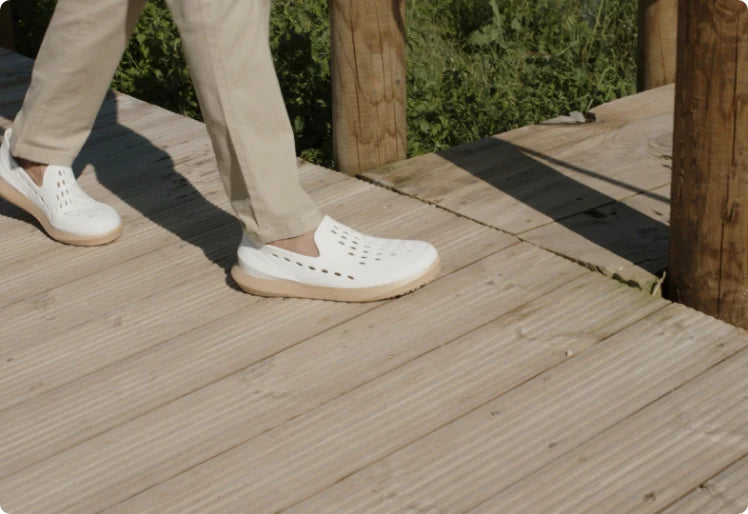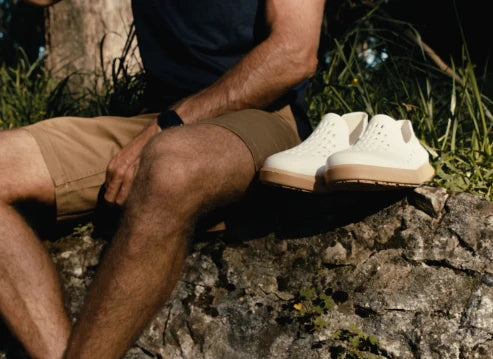Hiking Shoes for Walking: A Definitive Answer
Comfortable and supportive footwear is crucial for walking. Whether you're strolling through city streets or embarking on a nature trail, the right shoes can make all the difference. Hiking shoes are often considered for their ruggedness and durability, but can they really serve well as walking shoes?
Benefits to Consider:
- Rugged Design: Handles different terrains effortlessly
- Excellent Traction: Prevents slips and falls
- Waterproof Features: Keeps feet dry in various conditions
Potential Drawbacks:
- Stiffness and Weight: Might be cumbersome for everyday use
- Breathability Issues: Can lead to discomfort during long walks
Exploring these aspects helps you understand whether hiking shoes could be your next favorite pair for walking.
Ready to dive deeper? Let’s explore the benefits of hiking shoes for walking.
Benefits of Hiking Shoes for Walking
1. Ruggedness and Terrain Handling
Hiking shoes are built to be rugged, making them perfect for various terrains. Whether you're walking on asphalt, gravel paths, or forest trails, these shoes can handle it all. Their sturdy design ensures durability and longevity, allowing you to walk comfortably without worrying about wear and tear.
2. Traction for Stability
One of the standout features of hiking shoes is their excellent traction. They come with specialized outsoles that provide a strong grip on different surfaces. This traction is crucial for maintaining stability and preventing slips, especially when walking on uneven or slippery ground.
3. Waterproof Features
Another significant benefit of hiking shoes is their waterproof capability. Walking in wet conditions can be uncomfortable and even harmful if your feet get soaked. Waterproof hiking shoes keep your feet dry, ensuring a more pleasant walking experience regardless of the weather.
For more versatile footwear options, check out Strato Footwear. They offer a range of stylish and comfortable shoes suited for different needs.
If you're interested in exploring different shoe styles beyond hiking shoes, consider incorporating white shoes into your wardrobe. This blog post provides insights into the best white shoes to own and offers fashion tips on how to seamlessly incorporate them into various outfits.
In summary, the ruggedness, traction, and waterproof features of hiking shoes make them an excellent choice for walking in diverse conditions.
Comfort, Support, and Other Features that Matter in Hiking Shoes for Walking
Key Role of Comfort and Support
Comfort and support are crucial when selecting footwear for any walking activity. Hiking shoes excel in providing these essential features:
- Cushioned midsoles: Reduce the impact on your feet during prolonged walks.
- Supportive footbeds: Help maintain proper foot alignment, reducing fatigue.
- Ankle support: Essential for preventing injuries, especially on uneven surfaces.
Protection and Stability on Uneven Surfaces
Hiking shoes are designed to handle rough terrains, offering protection and stability:
- Toe caps: Shield your toes from rocks and debris.
- Sturdy outsoles: Provide excellent grip, preventing slips on uneven trails.
- Reinforced stitching: Enhances durability, ensuring your shoes last longer.
Materials Used in Hiking Shoes
The choice of materials significantly impacts comfort and durability:
- Leather: Known for its durability and ability to mold to your feet over time.
- Synthetic fabrics: Lightweight and often more breathable compared to leather.
- Gore-Tex or other waterproof membranes: Keep your feet dry in wet conditions.
Cushioning Technology and Supportive Footbeds
Innovative cushioning technologies enhance walking comfort:
- EVA foam midsoles: Offer lightweight cushioning with excellent shock absorption.
- Ortholite insoles: Provide long-lasting cushioning and moisture management.
- Gel or air pockets: Found in some models for additional shock absorption.
Hiking shoes are designed with features that cater specifically to the challenges of uneven terrain. Their robust construction not only supports but also protects the feet, making them a viable option for various walking activities.
For those looking for a versatile pair of shoes that can handle different types of walking scenarios, Strato Swank Black and White Shoes offer an elegant solution suitable for any occasion. These shoes combine style with the necessary features for comfortable walking.
If you're unsure about which pair to choose or need to return an unsuitable pair, refer to the Strato Refund Policy for guidance. The policy outlines the return eligibility criteria and provides helpful instructions to ensure a smooth return process.
Choosing hiking shoes for walking ensures you benefit from advanced comfort technologies, robust support structures, and durable materials that can withstand regular use.
Considering the Drawbacks of Using Hiking Shoes for Walking
When deciding whether to use hiking shoes for walking, it is essential to consider some potential drawbacks.
Stiffness and Weight
- Stiffness: Hiking shoes are designed for rugged terrains, which means they often have a stiffer sole. This can provide stability on uneven surfaces but might feel rigid and uncomfortable during regular walks on flat paths or pavements.
- Weight: Compared to typical walking shoes, hiking shoes tend to be heavier. The added weight can make them less ideal for casual strolls or everyday use, potentially leading to fatigue over long distances.
Overkill for Less Demanding Walks
Hiking shoes are built to withstand challenging trails and rough conditions. For someone who's primarily walking on smooth surfaces or doing light walking, these features may be unnecessary and even cumbersome.
Limited Breathability
Many hiking shoes are constructed with durable materials like leather or synthetic fabrics that prioritize durability and water resistance over breathability. Limited airflow can result in sweaty feet, making them less comfortable during warmer weather or longer walks.
Style and Aesthetics
While functionality is paramount in hiking shoes, their bulky design might not appeal to everyone. They may not blend well with casual or formal attire, limiting their versatility beyond outdoor activities.
Cost Considerations
High-quality hiking shoes often come with a higher price tag due to their specialized features and durable construction. This cost might not be justifiable if the primary purpose is simple daily walks rather than challenging hikes.
When evaluating footwear options, it's crucial to weigh these factors:
- Flexibility: Ensuring that the shoe provides adequate flexibility for your specific walking needs.
- Cost: Balancing the price against the frequency and type of use.
- Style Preferences: Choosing a shoe that fits your aesthetic while still offering necessary support.
Personal Preference: Deciding Factor for Choosing Hiking Shoes or Other Types of Walking Shoes
Personal preference plays a crucial role in determining whether hiking shoes are suitable for walking or if another type of walking shoe might be better. Everyone's feet, walking habits, and comfort levels are different, so it's essential to consider what works best for you.
Guidelines for Selecting the Right Pair of Walking Shoes
1. Leisurely Strolls
- Opt for lightweight and flexible shoes.
- Prioritize breathability and comfort.
- Look for stylish designs that match your everyday attire.
2. Trail Hikes
- Choose rugged hiking shoes with excellent traction.
- Ensure they offer ample support and cushioning.
- Waterproof features can be beneficial for varying conditions.
3. Urban Exploration
- Consider walking shoes that blend durability with style.
- Emphasize shock-absorbing soles for hard surfaces like pavement.
- Seek out versatile options that can handle both city streets and occasional off-road paths.
4. Long-Distance Walking
- Focus on shoes with superior cushioning and support.
- Check for durable materials that can withstand extended use.
- Pay attention to fit and stability to avoid blisters and discomfort.
Understanding your specific walking needs helps in making a more informed decision. Whether you lean towards hiking shoes or specialized walking shoes, what matters most is prioritizing comfort, support, and suitability to your lifestyle and activities.
Conclusion
Hiking shoes are incredibly versatile, making them suitable for both outdoor adventures and casual walks. They are designed with durability in mind, using high-quality materials that can withstand various terrains.
One of the key features of hiking shoes is their ability to provide excellent traction, thanks to their rugged construction. This ensures that you can maintain stability even on slippery surfaces.
Another advantage of hiking shoes is their waterproof feature, which helps to keep your feet dry in wet conditions. This is especially important when you're crossing streams or walking through muddy areas.
In terms of comfort, hiking shoes are specifically designed to support and cushion your feet. They often come with features like padded insoles and ankle support, reducing the risk of discomfort or injuries during long walks.
Key Takeaways:
- Versatile Use: Ideal for diverse walking conditions.
- Protection & Comfort: Designed to support and cushion your feet.
- Durability: Built to last with high-quality materials.
Your choice of footwear should always prioritize comfort and safety. Whether you opt for hiking shoes or another type of walking shoe, ensuring they meet your specific needs will make every step enjoyable.




